
Dante Alighieri, most likely baptized Durante di Alighiero degli Alighieri and often referred to as Dante, was an Italian poet, writer, and philosopher. His Divine Comedy, originally called Comedìa and later christened Divina by Giovanni Boccaccio, is widely considered one of the most important poems of the Middle Ages and the greatest literary work in the Italian language.

Florence is the capital city of the region of Tuscany in Central Italy. It is also the most populated city in Tuscany, with 360,930 inhabitants in 2023, and 984,991 in its metropolitan area.

Giovanni Boccaccio was an Italian writer, poet, correspondent of Petrarch, and an important Renaissance humanist. Born in the town of Certaldo, he became so well known as a writer that he was sometimes simply known as "the Certaldese" and one of the most important figures in the European literary panorama of the fourteenth century. Some scholars define him as the greatest European prose writer of his time, a versatile writer who amalgamated different literary trends and genres, making them converge in original works, thanks to a creative activity exercised under the banner of experimentalism.

The University of Florence is an Italian public research university located in Florence, Italy. It comprises 12 schools and has around 50,000 students enrolled.

Fiesole is a town and comune of the Metropolitan City of Florence in the Italian region of Tuscany, on a scenic height above Florence, 5 km northeast of that city. It has structures dating to Etruscan and Roman times.

Boccaccio, oder Der Prinz von Palermo is an operetta in three acts by Franz von Suppé to a German libretto by Camillo Walzel and Richard Genée, based on the play by Jean-François Bayard, Adolphe de Leuven, Léon Lévy Brunswick and Arthur de Beauplan, based in turn on The Decameron by Giovanni Boccaccio. Despite the opera's clear links to the Viennese opera tradition, Suppé's opera takes most of its style from Italian opera.
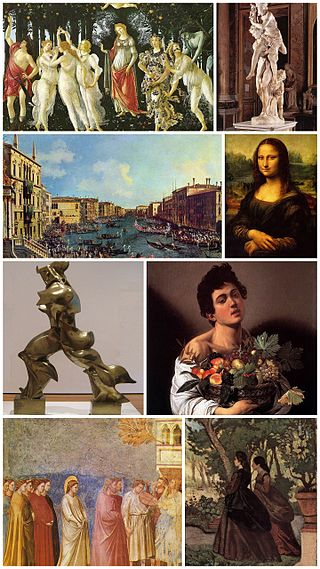
The Trecento refers to the 14th century in Italian cultural history.
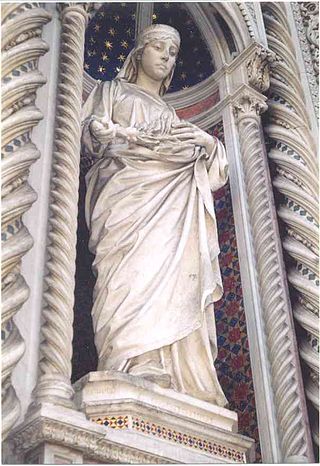
Florence weathered the decline of the Western Roman Empire to emerge as a financial hub of Europe, home to several banks including that of the politically powerful Medici family. The city's wealth supported the development of art during the Italian Renaissance, and tourism attracted by its rich history continues today.
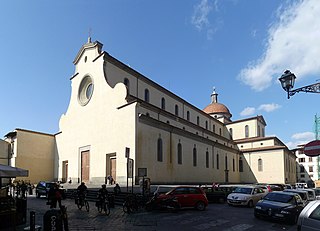
The Basilica di Santo Spirito is a church in Florence, Italy. Usually referred to simply as Santo Spirito, it is located in the Oltrarno quarter, facing the square with the same name. The interior of the building – internal length 97 m (318 ft) – is one of the preeminent examples of Renaissance architecture.

Leopoldo Mugnone was an Italian conductor, especially of opera, whose most famous work was done in the period 1890–1920, both in Europe and South America. He conducted various operatic premieres, and was also a composer of operas.
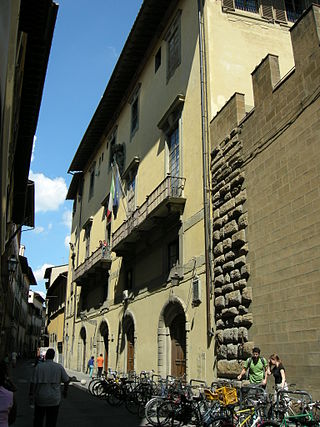
The Biblioteca Riccardiana is an Italian public library under the aegis of the Ministry of Culture, located inside the Palazzo Medici Riccardi at 10 Via de’ Ginori in Florence, in the neighborhood comprising the Mercato Centrale and the Basilica di San Lorenzo. Its main feature is preserving books collected by members of the Riccardi family and making them available in the very same rooms that were originally dedicated to that purpose. So, still today the library boasts the magnificent bookshelves, neatly carved and gilded, that create the atmosphere of a late-seventeenth-century patrician library, whose main features have all been kept intact.
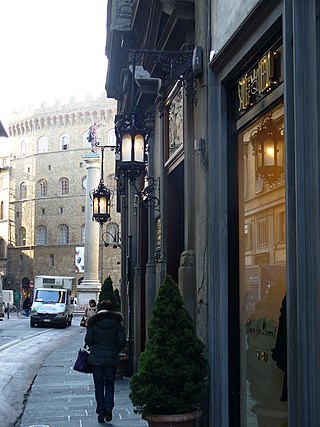
Via de' Tornabuoni, or Via Tornabuoni, is a street at the center of Florence, Italy, that goes from Antinori square to Ponte Santa Trinita, across Santa Trinita square, distinguished by the presence of fashion boutiques.

Giovanni Targioni Tozzetti was an Italian botanist and naturalist.
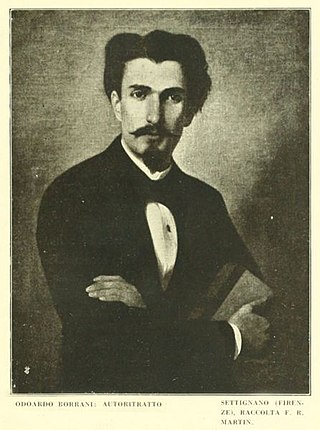
Odoardo Borrani was an Italian painter associated with the Macchiaioli group.

Ulvi Liegi was an Italian painter and printmaker. Part of the Post-macchiaioli movement, he painted various cityscapes of Livorno and depictions of Livornese daily life.
The Accademia Fiorentina was a philosophical and literary academy established in Florence in the Republic of Florence during the Italian Renaissance. It was active from 1540 to 1783.

The Metropolitan City of Florence is an administrative division called metropolitan city in the Tuscany region, Italy. Its capital is the city of Florence. It replaced the Province of Florence. It was first created by the reform of local authorities and then established by the Law 56/2014. It has been operative since 1 January 2015.

Florentia was a Roman city in the Arno valley from which Florence originated. According to tradition, it was built by the legions of Gaius Julius Caesar in 59 BC; however, the prevailing hypothesis dates the foundation of the city to the Augustan period.

The Terzolle stream in origin was a tributary of the Arno stream, now it's a tributary of Mugnone stream ; it makes its short journey in the area of Florence.



















